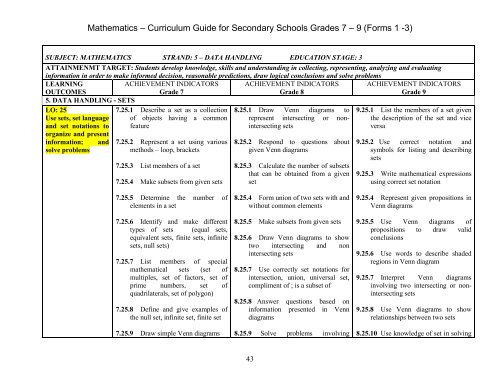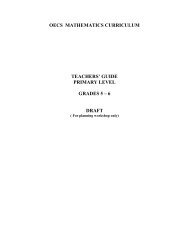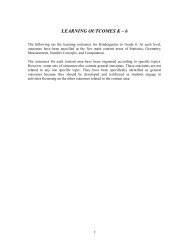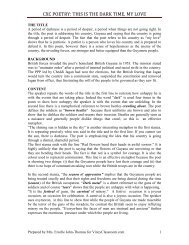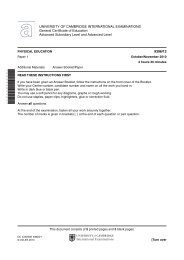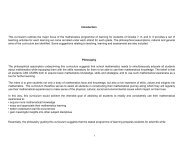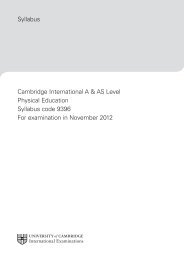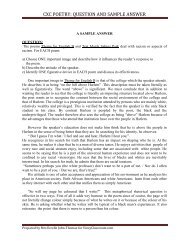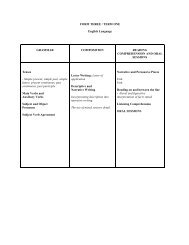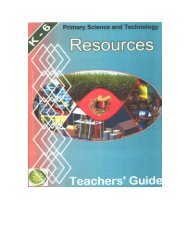Mathematics Programme of Learning - VincyClassroom
Mathematics Programme of Learning - VincyClassroom
Mathematics Programme of Learning - VincyClassroom
You also want an ePaper? Increase the reach of your titles
YUMPU automatically turns print PDFs into web optimized ePapers that Google loves.
<strong>Mathematics</strong> – Curriculum Guide for Secondary Schools Grades 7 – 9 (Forms 1 -3)<br />
SUBJECT: MATHEMATICS STRAND: 5 – DATA HANDLING EDUCATION STAGE: 3<br />
ATTAINMENMT TARGET: Students develop knowledge, skills and understanding in collecting, representing, analyzing and evaluating<br />
information in order to make informed decision, reasonable predictions, draw logical conclusions and solve problems<br />
LEARNING<br />
OUTCOMES<br />
ACHIEVEMENT INDICATORS<br />
Grade 7<br />
ACHIEVEMENT INDICATORS<br />
Grade 8<br />
ACHIEVEMENT INDICATORS<br />
Grade 9<br />
5. DATA HANDLING - SETS<br />
7.25.1 Describe a set as a collection 8.25.1 Draw Venn diagrams to 9.25.1 List the members <strong>of</strong> a set given<br />
<strong>of</strong> objects having a common represent intersecting or nonintersecting<br />
the description <strong>of</strong> the set and vice<br />
feature<br />
sets<br />
versa<br />
LO: 25<br />
Use sets, set language<br />
and set notations to<br />
organize and present<br />
information; and<br />
solve problems<br />
7.25.2 Represent a set using various<br />
methods – loop, brackets<br />
7.25.3 List members <strong>of</strong> a set<br />
7.25.4 Make subsets from given sets<br />
8.25.2 Respond to questions about<br />
given Venn diagrams<br />
8.25.3 Calculate the number <strong>of</strong> subsets<br />
that can be obtained from a given<br />
set<br />
9.25.2 Use correct notation and<br />
symbols for listing and describing<br />
sets<br />
9.25.3 Write mathematical expressions<br />
using correct set notation<br />
7.25.5 Determine the number <strong>of</strong><br />
elements in a set<br />
7.25.6 Identify and make different<br />
types <strong>of</strong> sets (equal sets,<br />
equivalent sets, finite sets, infinite<br />
sets, null sets)<br />
7.25.7 List members <strong>of</strong> special<br />
mathematical sets (set <strong>of</strong><br />
multiples, set <strong>of</strong> factors, set <strong>of</strong><br />
prime numbers, set <strong>of</strong><br />
quadrilaterals, set <strong>of</strong> polygon)<br />
7.25.8 Define and give examples <strong>of</strong><br />
the null set, infinite set, finite set<br />
7.25.9 Draw simple Venn diagrams<br />
8.25.4 Form union <strong>of</strong> two sets with and<br />
without common elements<br />
8.25.5 Make subsets from given sets<br />
8.25.6 Draw Venn diagrams to show<br />
two intersecting and non<br />
intersecting sets<br />
8.25.7 Use correctly set notations for<br />
intersection, union, universal set,<br />
compliment <strong>of</strong> ; is a subset <strong>of</strong><br />
8.25.8 Answer questions based on<br />
information presented in Venn<br />
diagrams<br />
8.25.9 Solve problems involving<br />
9.25.4 Represent given propositions in<br />
Venn diagrams<br />
9.25.5 Use Venn diagrams <strong>of</strong><br />
propositions to draw valid<br />
conclusions<br />
9.25.6 Use words to describe shaded<br />
regions in Venn diagram<br />
9.25.7 Interpret Venn diagrams<br />
involving two intersecting or nonintersecting<br />
sets<br />
9.25.8 Use Venn diagrams to show<br />
relationships between two sets<br />
8.25.10 Use knowledge <strong>of</strong> set in solving<br />
43


